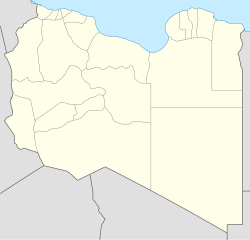Al Khums
|
Al-Khums الخمس Khoms, Homs |
||
|---|---|---|

"17 February Martyrs Monument" in Khums center
|
||
|
||
| Location in Libya | ||
| Coordinates: 32°38′59″N 14°15′52″E / 32.64972°N 14.26444°ECoordinates: 32°38′59″N 14°15′52″E / 32.64972°N 14.26444°E | ||
| Country |
|
|
| Region | Tripolitania | |
| District | Murqub | |
| Settled by Berbers and Phoenicians | around 1000 BC (as Lpqy) | |
| Government | ||
| • Governing body | Al-Khums Municipal Council | |
| • President of the Municipal Council | Bashir Alhnash | |
| Elevation | 7 ft (2 m) | |
| Population (2004) | ||
| • Total | 201,943 | |
| Demonym(s) | Khumsi | |
| Time zone | EET (UTC+2) | |
| Area code(s) | 31 | |
| Website | http://khoms.gov.ly/ | |
Al Khums or Khoms (Arabic: الخمس) is a city, port and the de jure capital of the contested Murqub District on the Mediterranean coast of Libya with an estimated population of around 202,000. The population at the 1984 census was 38,174. Between 1983 and 1995 it was the administrative center of the Al Khums District.
The name Al Khums, Khoms or sometimes Homs (Arabic: الخُمس ) translated literally to "" in Arabic. The origins of the name is not clear, though there are many theories explaining it. The most renowned are:
During the Italian occupation of Libya, the city was called Homs in the official Italian sources.
The city appears to have been founded by a group of local Berbers (and probably Phoenicians) sometime around 1000 BC, who gave it the Lybico-Berber name Lpqy.
The town did not achieve prominence until Carthage became a major super power in the Mediterranean Sea in the 4th century BC. It nominally remained part of Carthage's dominions until the end of the Third Punic War in 146 BC and then became part of the Roman Republic, although from about 111 BC onward, it was for all intents and purposes an independent city.
Soon Italian merchants settled in the city and started a profitable commerce with the Libyan interior. The republican Rome sent some colonists together with a small garrison in order to control the city. Since then the city started to grow and was even allowed to create its own money (coins).
Leptis Magna remained as such until the reign of the Roman emperor Tiberius, when the city and the surrounding area were formally incorporated into the empire as part of the province of Africa. It soon became one of the leading cities of Roman Africa and a major trading post.
...
Wikipedia


